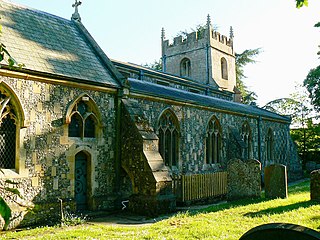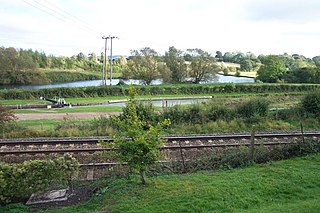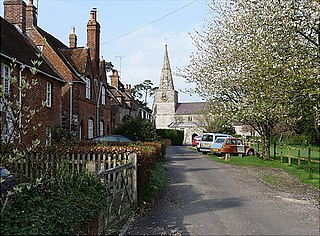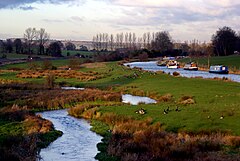
Hungerford is a historic market town and civil parish in Berkshire, England, 8 miles (13 km) west of Newbury, 9 miles (14 km) east of Marlborough, 27 miles (43 km) north-east of Salisbury and 60 miles (97 km) west of London. The Kennet and Avon Canal passes through the town alongside the River Dun, a major tributary of the River Kennet. The confluence with the Kennet is to the north of the centre whence canal and river both continue east. Amenities include schools, shops, cafés, restaurants, and facilities for the main national sports. Hungerford railway station is a minor stop on the Reading to Taunton Line.

Devizes is a market town and civil parish in Wiltshire, England. It developed around Devizes Castle, an 11th-century Norman castle, and received a charter in 1141. The castle was besieged during the Anarchy, a 12th-century civil war between Stephen of England and Empress Matilda, and again during the English Civil War when the Cavaliers lifted the siege at the Battle of Roundway Down and the Parliamentarian Army of the West under Sir William Waller was routed. Devizes remained under Royalist control until 1645, when Oliver Cromwell attacked and forced the Royalists to surrender. The castle was destroyed in 1648 on the orders of Parliament, and today little remains of it.

The Vale of Pewsey or Pewsey Vale is an area of Wiltshire, England to the east of Devizes and south of Marlborough, centred on the village of Pewsey.

Pewsey is a village and civil parish at the centre of the Vale of Pewsey in Wiltshire, about 6 miles (10 km) south of Marlborough and 71 miles (114 km) west of London. It is within reach of the M4 motorway and the A303 and is served by Pewsey railway station on the Reading to Taunton line.

The Wilton Windmill is a five-floor brick tower mill, standing on a chalk ridge between the villages of Wilton and Great Bedwyn in the southern English county of Wiltshire.

Bishops Cannings is a village and civil parish in the Vale of Pewsey in Wiltshire, England, 3 miles (5 km) north-east of Devizes. The parish includes the village of Coate and the hamlets of Bourton, Horton and Little Horton.

Burbage is a village and civil parish in the Vale of Pewsey, Wiltshire, England. It is about 6 miles (9.7 km) south of Marlborough and 20 miles (32 km) west of Newbury.

Grafton is a civil parish in Wiltshire, England, in the Vale of Pewsey about 7 miles (11 km) southeast of Marlborough. Its main settlement is the village of East Grafton, on the A338 Burbage - Hungerford road; the parish includes the village of Wilton and the hamlets of West Grafton, Marten and Wexcombe.

Bedwyn railway station serves the village of Great Bedwyn in Wiltshire, England. It is 66 miles 33 chains from the zero point at London Paddington. Along with Pewsey station, it serves the market town of Marlborough which is 6 miles (10 km) away. A bus from the town connects with most trains on Mondays to Saturdays.

Savernake Forest stands on a Cretaceous chalk plateau between Marlborough and Great Bedwyn in Wiltshire, England. Its area is approximately 4,500 acres.

The River Dun is a tributary of the River Kennet, flowing through Wiltshire and Berkshire in England. Its main source is in the parish of Great Bedwyn, Wiltshire and it flows 16 kilometres (10 mi) in a northeasterly direction into Berkshire. It discharges into the Kennet at Hungerford, which has a smaller average flow and width upstream of that point.

Crofton Locks are a flight of locks on the Kennet and Avon Canal, near the village of Great Bedwyn, Wiltshire, England.

Wilton Water is a small reservoir, southwest of the village of Great Bedwyn in the English county of Wiltshire, which supplies the summit pound of the Kennet and Avon Canal with water. The reservoir lies in the parish of Grafton and collects rainfall from the eastern end of the Vale of Pewsey and the surrounding hills.

Wulfhall or Wolfhall is an early 17th-century manor house in Burbage parish, Wiltshire, England. It is north-east of Burbage village, and about 5 miles (8 km) south-east of Marlborough. A previous manor house on the same site, at that time in the parish of Great Bedwyn, was the seat of the Seymour family, a member of which, Jane Seymour, was queen to King Henry VIII.

Little Bedwyn is a village and civil parish on the River Dun in Wiltshire, England, about 3 miles (4.8 km) south-west of the market town of Hungerford in neighbouring Berkshire. The parish includes the hamlet of Chisbury.

Savernake Low Level railway station was a station on the Berks and Hants Extension Railway, near the village of Burbage in Wiltshire, England. It was open from 1862 until 1966.

Savernake is a civil parish immediately south and southeast of Marlborough in Wiltshire, England. The settlements in the parish are the hamlets of Cadley,Clench Common and Forest Hill. Savernake Forest covers the eastern half of the parish.
John Blackwell was an English civil engineer, known for his work as superintending engineer of the Kennet and Avon Canal under John Rennie and later as the canal company's resident engineer.

The Church of Saint Mary the Virgin is the parish church of Great Bedwyn, Wiltshire, England, and a Grade I listed building. The church was built in the Norman style in the 12th century, but beneath the existing building are Saxon remains dating back to the 10th century. The church boasts a handsome memorial to Sir John Seymour, father of King Henry VIII's wife Jane Seymour, and grandfather of King Edward VI of England.





















